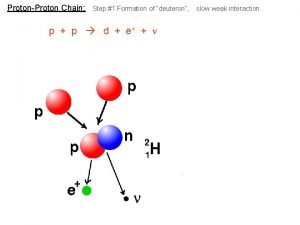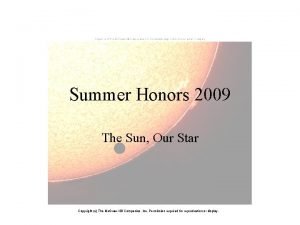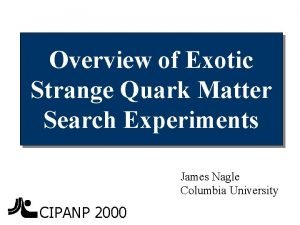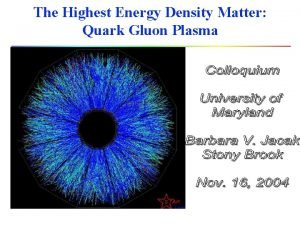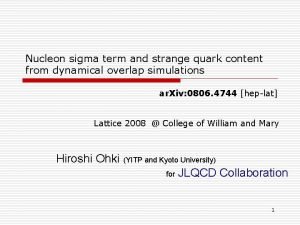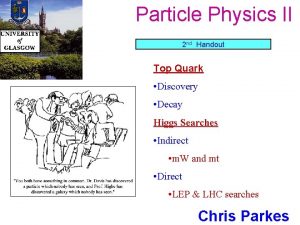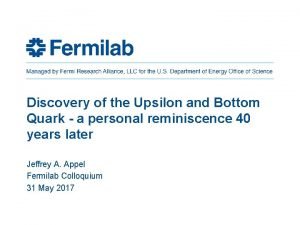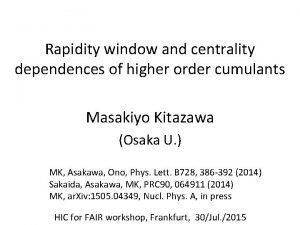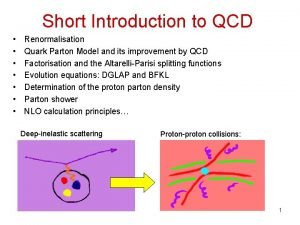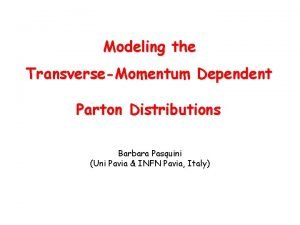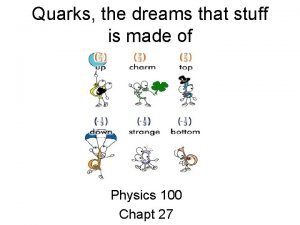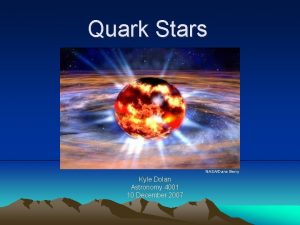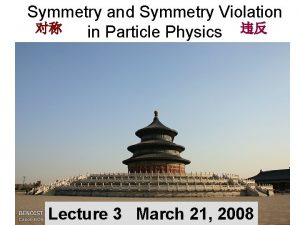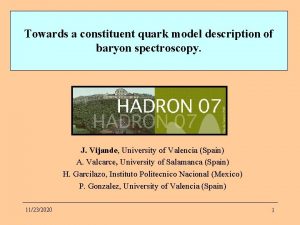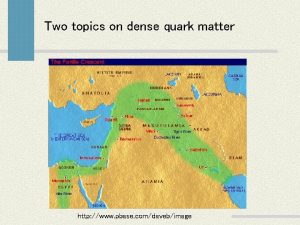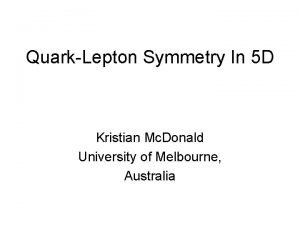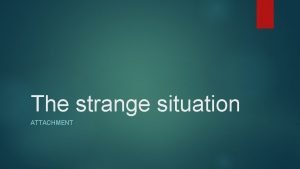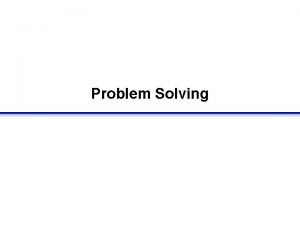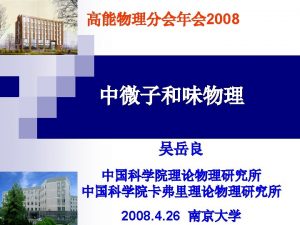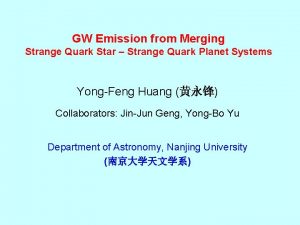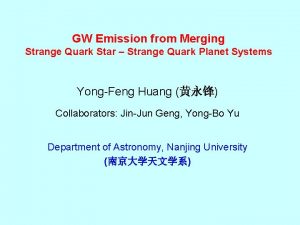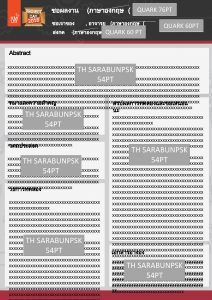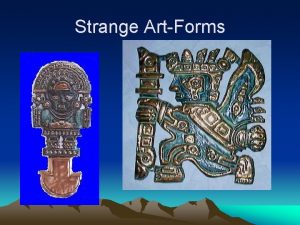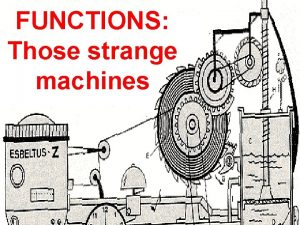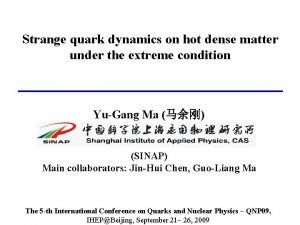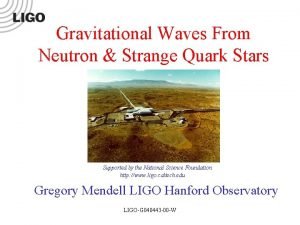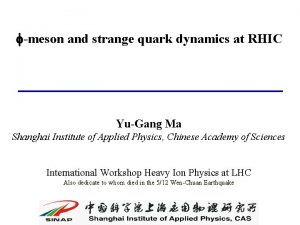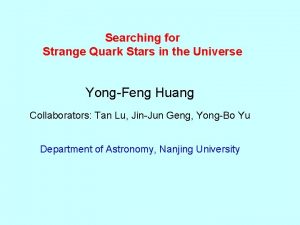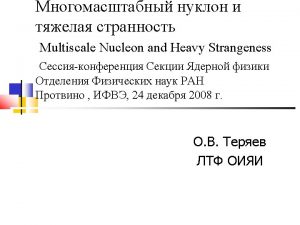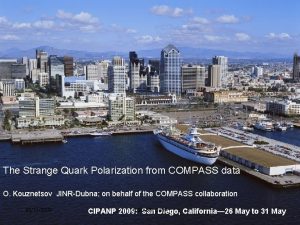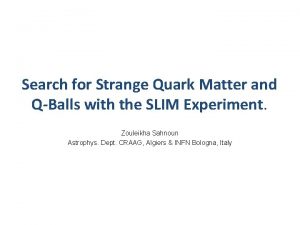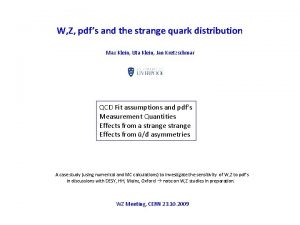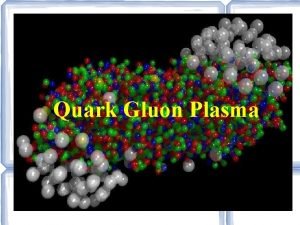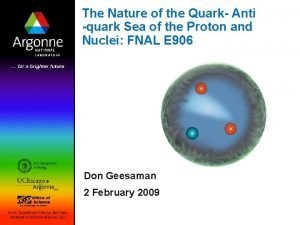The strange quark content of the proton From






























- Slides: 30

The strange quark content of the proton From studying inclusive W, Z data from ATLAS and CMS A M Cooper-Sarkar and K Wichmann • ar. Xi. V: 1803. 00968 1

We have seen that the ATLAS inclusive W, Z 2011 precision data ar. XIV: 1612. 03016 Imply unsuppressed strangeness Profiling other PDFsets tells the same storymore strangeness at low-x We consider strangeness in ratio to the light quark PDFs as a function of x Not just at a single x, Q 2 point We also see it in 13 Tev supressed W/Z ratio 2

But do we see it in W+c production? —ATLAS does, CMS does NOT ar. Xiv: 1402. 6263 ATLAS data agrees with PDFs which have unsuppressed strangeness CMS – now at 13 Te. V--data has a smaller cross section and less strangeness CMSPAS-SMP-17 -014 BUT 1) If the full error band of the ATLAS inclusive analysis is laid on the CMS plot the discrepancy is not so eye-catching 2) CMS still implies larger strangeness than the conventional 0. 5 suppression at low –x, x< 0. 005 3

Where does the original evidence for strangeness suppression come from? From neutrino dimuon data: at low scale ~a few Ge. V 2 and high-ish x~ 0. 1 W+charm production at the LHC does not suffer from nuclear effects but there is still a need for assumptions on charm jet frasgmentation and hadronisation. It is quite a long way from the raw data to the W+c cross section So we ask the question what do inclusive W and Z data from both CMS and ATLAS tell us? The Drell-Yan process is theoretically best understood process in p-p collisions. We know that we can take the PDFs from Deep Inelastic Scattering and use them in this process, the factorisation theorem is proven. 4

Where does the to evidence strangeness from inininclusive W and Z Flavour contributions W and Zon show that s-sbarcome is prominent Z production at central production? rapidity. Flavour contributions to W Z show that s-sbar is prominent in Z production at These plots were made for theand usual assumption that strange sea is suppressed ~0. 5 of central rapidity. down-type sea How would Z and W rapidity spectra at the LHC change if strangeness were enhanced? Consider the ratio of Z and W cross-sections for (strange = down sea) in ratio to (strange = 0. 5 down sea) The shape of the Z rapidity distribution is affected – the W distributions are notthus they give an absolute normalisation for the change in Z This is a small effect ~ 4%- can we see it? - it seems that we can 5

The questions we are now addressing are: 1. Is there tension between CMS and ATLAS inclusive data sets 2. What is the strangeness ratio using BOTH CMS and ATLAS inclusive W, Z data? How do we do this? We have to make a full PDF fit. This cannot be done with just ATLAS W, Z data BUT we can add it to the HERA deepinelastic scattering data. § HERA data from HERA combination 1056 data points, 169 sources of correlated systematic uncertainty § ATLAS W, Z data at 7 Te. V: 61 data points, 43 in central region, 131 sources of correlated systematic uncertainty § CMS W, Z data at 7 Te. V: 119 data points, 35 in central region, normalised Z data and 11 data points W-asymmetry § CMS W at 8 Te. V: 22 or 11 data points (used as W+, W- checked using W-asymmetry) § CMS Z data at 8 Te. V: 108 data points, 24 in central region – not used in main fit 6

Details § § QCDNUM for DGLAP evolution at NNLO DIS matrix-elements also from QCDNUM with RTVFN heavy quark scheme W, Z matrix elements at NLO from MCFM using Applgrid for input to PDF fit Augmented with NNLO/NLO k-factors from DYNNLO cross-checked with FEWZ for ATLAS, just FEWZ for CMS. § NLO-EW and photon induced corrections also applied for ATLAS § The Main Fit uses W+, W- data and data from the Z central region (66 -116 Ge. V for ATLAS , 60 -120 Ge. V for CMS) since corrections for EW and PI effects are larger off-peak. However, checks are made for the Z-off peak data. § The lowest off-peak bin 20 -30 Ge. V is not used at all since NNLO/NLO k-factors cannot be reliably estimated (process is ~zero at LO) § The 8 Te. V CMS Z data are not used in the main fit since the covariance matrix leads to unreasonably large chisq, as found by other PDF groups. However a check is made with these data. Work is currently going on within CMS to address this problem 7

As usual, we assume PDF shapes at a low starting scale. Perform DGLAP evolution to the scale of the measurements –and convolute the evolved PDFs with the hard process matrix-elements to calculate the crosssections. We then fit the data by varying the parameters A, B, C, E in the starting shapes. The parameters are chosen by ‘saturation of χ2’ such that addition of extra parameters does not improve the fit. In the main fit we have Bubar =Bdbar = Bsbar and Aubar= A dbar ie low-x dbar=ubar plus the slope of sbar (but not necessarily its magnitude)= slope dbar= slope ubar There are other assumed values in constructing the predictions and these are included as part of model uncertainties and ɑS(MZ) uncertainty However, extra parameters can change the shape of the PDFs, even if they don’t improve the χ2. These are included as part of parametrisation uncertainty. 8

Use a form of χ2 which accounts for correlated systematics using nuisance parameters bj for each source of systematic j for ATLAS Where µi is the measurement for point i , mi is the prediction, γij is the fractional systematic errors on point I from source j and δ’s are uncorrelated errors. For CMS use covariance matrices which contain systematic and statistical components There is just one systematic shift for the 8 Te. V CMS Z data which are not normalised —namely the normalisation systematic parameter 9

Consider W and Z data sets from each Very similar valence, gluon and total sea PDFs experiment separately Different flavour break up to strangeness BUT none are as suppressed as Rs = 0. 5 10

Then consider ATLAS +CMS for W And ATLAS+CMS for Z central Z is much more strangeness sensitive than W Z and W together has a different shape because of the ATLAS correlations. Note the χ2 for ATLAS and CMS together shows no tension between 11 the data sets

Then consider CMS W+Z and ATLAS W+Z and compare to ALL: no tension, disagreement in strangeness is only at 1. 5σ level. ATLAS is more accurate and thus dominates the fit to both together 12

Let’s take a brief pause to look at the effect of the ATLAS and CMS W and Z data on PDF uncertainties The ATLAS and CMS W data are equally constraining wrt valence distributions- as seen here with dv, whereas the Z data are not so constraining. However if we look at sea-quarks then the ATLAS Z are always the most constraining, followed by ATLAS W, CMS W and CMS Z- as seen here on the total sea, strange sea and strangeness ratio 13

Now add off-peak Z bins as a check High mass : 116 -136 Ge. V ATLAS (central and forward rapidity) 120 -200 Ge. V CMS 200 -1500 Ge. V CMS Low Mass: 46 -66 Ge. V ATLAS 30 -45 Ge. V CMS 45 -60 Ge. V CMS • The result for strangeness is barely affected • Even uncertainties are not much improved • The off peak bins are well described (apart from ATLAS lowest mass bin, as also found by ATLAS) • Not worth the added uncertainty from EW and PI effects 14

Now add CMS 8 Te. V Z data both central and offpeak The 8 Te. V data are not well fitted- as also found by NNPDF The result for strangeness at low-x is not affected significantly 15

For the Main fit to the ATLAS and CMS W and Z-peak data (excluding CMS 8 Te. V) we consider model variations, parametrisation variations and alphas variations. We characterise them in the value of Rs at The strangeness ratio is shown as a function of x including the model and parametrisation variations here 16

Note worthy parametrisation variations are: • Allowing the low-x sea parameter Bsbar to be free • Allowing ubar to be free from dbar at low-x, so Aubar and Bubar are additional free parameters. • Combining these two to allow freedom in low-x, ubar, dbar simultaneously The data are consistent with the ubar and dbar distributions being very similar at low-x even when freedom is allowed. The extra freedom for low-x sbar leads to even more strangeness at low-x!! These parameters are now part of the standard parametrisation uncertainty (unlike for the ATLAS study where they were additional cross-checks. ) A further variation forces the fit to describe E 866 data -which gives dbar-ubar positive at high x ~0. 1 - by using the ZEUS-S parametrisation, (which fits dbar+ubar and fixes dbar-ubar). This gives Rs=0. 95 pm 0. 07, still enhanced but 2σ away from our central result. However, this is a poor fit to the HERA+ATLAS/CMS data χ2/ndf=1363/1142 rather than ~1308/1141 for the standard fits

Conclusions • No tension ATLAS vs CMS, in either W or Z • Enhanced strangeness is supported by both CMS and ATLAS Extra freedom in the low-x ubar, dbar and sbar still supports this conclusion 18

19

Flavourcontributions Z show s-sbar is prominent in Z production at Flavour to to WW andand Z show that s-sbar is prominent in Z production at central rapidity. These plots were made for the usual assumption that strange sea is suppressed ~0. 5 of down-type sea How would Z and W rapidity spectra at the LHC change if strangeness were enhanced? Consider the ratio of Z and W cross-sections for (strange = down sea) in ratio to (strange = 0. 5 down sea) The shape of the Z rapidity distribution is affected – the W distributions are notthus they give an absolute normalisation for the change in Z This is a small effect ~ 4%- can we see it? - it seems that we can 20

We expect to see a modified shape of the Z rapidity spectrum according to the amount of strangeness. Let us remind ourselves what we saw before in the 2010 data PRL 109(2012)012001 Fixed sbar =0. 5 dbar, free sbar = dbar rs =s/d = 1. 00 ± 0. 20 exp ± 0. 07 mod +0. 10/ -0. 15 par +0. 06/ -0. 07 αs ± 0. 08 th Essentially the SHAPE of the Z rapidity distribution plus the W/Z normalisation constrain the strange quark for 10 -3 < x < 10 -1 A fit together with HERA data produced the ATLASep. WZ 12 PDF set

Another process which can yield information on strangeness is W+charm ATLAS data on W+D/D* and W+c-jet (JHEP 05(2014)068) agree with the ATLAS W, Z 2010 analysis Is there a disagreement with CMS W+c? 22

ar. Xiv: 1402. 6263 ATLAS data agrees with PDFs which have unsuppressed strangeness CMS – now at 13 Te. V--data has a smaller cross section and less strangeness CMS-PASSMP-17 -014 BUT CMS data still implies larger strangeness than the conventional suppression at low –x, x< 0. 01 Can one improve? YES new data is coming BUT W/Z +c cross-section is a long way from raw data with old CMS W+c 23

Compare the Main CSKK fit to ATLAS and CMS W data 24

Compare the Main CSKK Fit to ATLAS (central and forward rapidity) and CMS Z-peak data 25

Compare the CSKK+high. Mass+low. Mass fit to the CMS and ATLAS (central and forward rapidity) off-mass-peak data 26

The shifts of the nuisance parameters for systematic correlations are nearly all within one sigma The uncertainties were determined by the Hessian method but have been checke 27

Unsuppressed strangeness results in more Z and a low W/Z ratio. We see this in the ATLAS 2010 data and in the new analysis of 2011 data This is our own old fit ATLASep. WZ 12 We ALSO see it in the 13 Te. V data This figure is from ar. XIV: 1612. 03016

Flavour contributions to W and Z show that s-sbar is prominent in Z production at central rapidity. This plots were made for the usual assumption that strange sea is suppressed ~0. 5 of down-type sea This comes from di-muon production in neutrino induced deep inelastic scattering data. But these neutrino data are shot on heavy targets. This not only involves uncertain nuclear corrections for the struck parton, but also the possibility of absorption of the outgoing charmed particle in the nuclear medium But without worrying too much about this what does it give for strange compared to dbar? Assume s=sbar, violations are very small Clear suppression for x ~0. 1 Not so clear for lower x 29

Strangeness suppression is measured at low scale And once you evolve to Q 2~MW 2 30
 Fission definition
Fission definition Proton proton chain
Proton proton chain Proton proton chain
Proton proton chain Quark gluon plasma
Quark gluon plasma Quarks
Quarks Dimsi sir
Dimsi sir Quark gluon
Quark gluon Sigma quark composition
Sigma quark composition Top quark decay
Top quark decay Quark names
Quark names Quark gluon plasma
Quark gluon plasma Quark parton model
Quark parton model Quark matter 2022
Quark matter 2022 Quark names
Quark names Quark model
Quark model 6 types of quarks
6 types of quarks Quark astronomy
Quark astronomy Quark physics wordle
Quark physics wordle A charm quark has a charge of approximately
A charm quark has a charge of approximately Constituent quark model
Constituent quark model Quark gluon plasma
Quark gluon plasma Quark lepton symmetry
Quark lepton symmetry Dynamic content vs static content
Dynamic content vs static content Characteristics of esp
Characteristics of esp Strange situation strengths and weaknesses
Strange situation strengths and weaknesses How to solve this problem
How to solve this problem Mary cassatt margot in blue
Mary cassatt margot in blue We quail, money makes us quail.why?
We quail, money makes us quail.why? Strange hotels around the world
Strange hotels around the world Strange mask
Strange mask Science fiction
Science fiction
